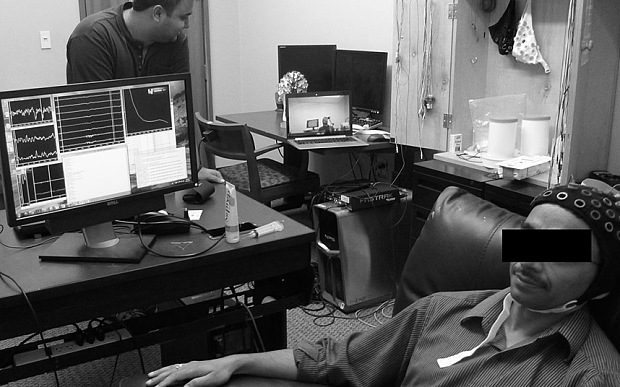|
Taking control of another person's body with your mind is something that has been long dreamed of in comic books and films like X Men, but now scientists have achieved it in real life.
Researchers used electromagnets and computers to transmit a person's brainwaves allowing them to control the hand of another sitting in a different building one mile away.
The technology recorded the brain signals from a computer gamer and then fired them into the brain of another volunteer, triggering the nerves that controlled their hand muscles.
This allowed the gamer, who had no physical computer controls themselves, to use the other person to play a computer game.
The technology makes it possible to control the body of another person with thoughts - something that Professor Xavier was able to do in the X Men.
The researchers behind the project believe it may eventually lead to new ways of helping rehabilitate stroke patients and those who have suffered brain damage.
It could also be used to pass information between people or allow skilled surgeons help others perform difficult operations from miles away or allow pilots to take control of a plane from the ground in an emergency.
Dr Rajesh Rao, a computer scientist and engineer at the University of Washington who led the work, said: "Our results show that information extracted from one brain can be transmitted to another brain, ultimately allowing two humans to cooperatively perform a task using only a direct brain-to-brain interface.
"Such devices, which have been long cherished by science fiction writers, have the potential to not only revolutionize how humans communicate and collaborate, but also open a new avenue for investigating brain function."
In the study, which is published in the journal Public Library of Science One, three pairs of volunteers played a rudimentary computer game where they had to fire a canon at passing pirate ships.
While one volunteer could see what was happening on the screen, the other in a different building could not see the screen but had their hand placed over a keypad needed to fire the canon.
The gamer who could see the screen was fitted with electroencephalograph, or EEG, to record the minute electrical signals that are given off by their brain.
With this they were able to transmit a distinctive signal to tap the keypad over the internet to a device that stimulated the brain of the second volunteer in the other room.
The signal was transmitted into the brain of the second volunteer through transcranial magnetic stimulation, or TMS, which generates an electromagnetic pulse that triggers the neurons in their brain.
When positioned over the part of the brain that controls movement in the right hand, this caused the muscles in volunteer's hand to move and tap the keypad.
The researchers, whose study said the technology needed little training for the volunteers to use and it was possible to trigger movement in the receiving person's hand less than 650 milliseconds after the sender gave the command to fire.
They found that the accuracy varied between the pairs with one managing to accurately hit 83 per cent of the pirate ships. Most of the misses were due to person sending the thoughts failing to accurately execute the thought needed to send the "fire" command.
Early brain to computer communication devices required many hours of training and required surgical implants.
Scientists have already enabled paralysed patients to control robotic arms and play computer games.
However, Dr Rao and his team believe their technology can be used by people who have just walked into their lab and do not require any invasive implants.
Recently scientists in Spain and France were able to show that they could send words to colleagues in India using similar set ups.
Those researchers recorded electrical activity from the brain and converted the words "hola" and "ciao" into a digital signal before electromagnetic pulses transmitted them into the receivers brain so they saw flashes of light that formed a kind of morse code.
Dr Rao and his team have now been given a $1 million grant from the WM Keck Foundation to transmit more complex brain processes.
They believe it may be possible to transmit other information such as concepts, abstract thoughts and rules as well as physical movement and information.
Dr Andrea Stocco, a psychologist at the University of Washington who was also involved in the study, said: "We have envisioned many scenarios in which brain-to-brain technology could be useful.
"A skilled surgeon could remotely control an inexperienced assistant's hands to perform medical procedures even it not on the site, or a skilled pilot could remotely help a less experienced one control a plane during a difficult situation.
"It could help with neuro-rehabilitation. After brain damage, patients need to painfully and slowly re-learn simple motor actions, such as walking, grasping, or swallowing.
"We suspect that the re-learning phase could be greatly sped-up if we could provide the damaged brain with a "motor template", copied from a healthy person, or the healthy part of the patient's brain, of what the intended action should look like.
"It could also help with tutoring. Imagine that we could extract the teacher's richer representation of a difficult concept and deliver it to his or her students in terms of neural activity."
|
人类一直以来梦想用意念控制他人身体,《X战警》等漫画和电影都曾描绘过这样的场景。现在,科学家已将这个梦想变为现实。
研究者使用电磁体和计算机传送一个实验对象的脑波,让这些脑波控制的另一个实验对象的手,而这个人坐在一英里外的不同建筑内。
该技术先把一个计算机游戏玩家的脑波记录下来,然后再将这些脑波发射到另一名志愿者的脑中,以触发其控制手部肌肉的神经。
这样就可以让那位无实体计算机操作的玩家通过他人玩游戏。
该项技术让人们用意念控制他人身体成为可能——就跟《X战警》中X教授查尔斯所具备的能力一样。
项目研究者相信,该技术最终可以提出新的方法,以协助康复中风病人及那些遭受脑损伤的人。
该项技术还可用于人与人之间的交流,或者让技能娴熟的外科医生协助远在几英里外的其他医生做颇有难度的手术。此外,它可以让飞行员在紧急情况下从地面控制一架飞机。
主导这项研究的华盛顿大学计算机科学家和工程师罗杰西·拉奥(Rajesh Rao)博士说,“我们的研究结果显示,从某人头脑获取的信息可传送到他人的脑中。只需通过一个直接的脑对脑程序接口,就可以让两人共同合作完成任务。”
“这种设备一直以来深受科幻小说家的推崇,它们不仅有望彻底改变人类通讯和合作方式,而且有可能为探索大脑功能开辟一条林荫大道。”
这项研究发表在《公共科学图书馆》杂志上。实验中,三对志愿者玩一款简单的电脑游戏——他们必须朝驶过的海盗船发射炮火。
每对志愿者中有一位可以看到屏幕,在不同建筑物的另一位则看不到屏幕,但需要把手放到键盘上以备发射炮火。
脑电图仪配备(EEG)给可以看到屏幕的那位玩家,以记录这两位玩家大脑发出的微弱电子信号。
凭借这种方法,他们能够把敲击键盘的特殊信号通过网络传输到一台促发第二位志愿者大脑活动的设备上(该志愿者在另一间房)。
这种信号通过“经颅磁刺激”(TMS)产生激发大脑神经的电磁脉冲,传送到第二位志愿者的大脑。
当信号到达脑中控制右手运动的部位时,就会促使志愿者的手部肌肉产生敲击键盘的动作。
研究者的研究表明,该技术操作方便,不需要对志愿者进行培训就能使用。发送者发出开火的指令后,接收者在650毫秒内就能收到该指令并促发自己的手部动作。
他们发现,每对志愿者的准确性有所不同,其中有一对成功消灭了83%的海盗船。没有打中的大部分原因可以归结为,传送意念的那位未能准确执行负责发射炮火的命令。
早期的脑-机通讯设备需要使用者训练很长时间,而且需要通过外科手术往人体内植入芯片等。
科学家已经能够让瘫痪病人操控机械臂玩电脑游戏。
但罗杰西·拉奥博士和他的团队认为,他们的技术更为先进,人们走进实验室,不需要通过训练就能使用,也不需要植入任何侵入人体的东西。
最近,西班牙和法国的科学家已能够向人们展示,他们能够使用类似的设备把要说的话成功地传送给在印度的同事。
这些研究者将大脑产生的电子活动记录下来,并把"hola"和"ciao"这两个词转换成数字信号,然后电磁脉冲再把它们传送到接收者大脑中,这样接收者就可以看到以莫尔斯电码形式出现的闪光。
目前,WM Keck基金会已给罗杰西·拉奥博士和他的团队提供了一笔一百万美元的经费,以期推进更复杂的大脑传输研究。
他们相信,将来有可能实现传送概念、抽象思维和规则以及身体运动之类的其它信息。
华盛顿大学心理学研究者安德里亚·斯托科(Andrea Stocco)博士也参与了这项研究,他说:“我们设想了很多‘脑对脑科技’发挥作用的场景。
“技术娴熟的外科医生能够在不在场的情况下,通过遥控经验尚浅的助手给病人做手术。缺乏经验的飞行员面临困境时,经验丰富的飞行员可远程协助其操控飞机。
“它可以帮助恢复神经。大脑损伤之后,病人需要痛苦而缓慢地重学简单的肌肉运动,比如走路、抓握、吞咽。
“我们认为,可以从健康的人或病人未受损的大脑部位复制一份‘运动神经模板’,并提供给受损的大脑,这样就能大大加速这种重学过程。
“它也能助教学一臂之力。想象一下,我们可以从教师脑中获取其对复杂概念的生动有趣的表述,并通过神经活动将之传送给他或她的学生。”
(译者 li2013 编辑 祝兴媛)
扫一扫,关注微博微信
 
|

